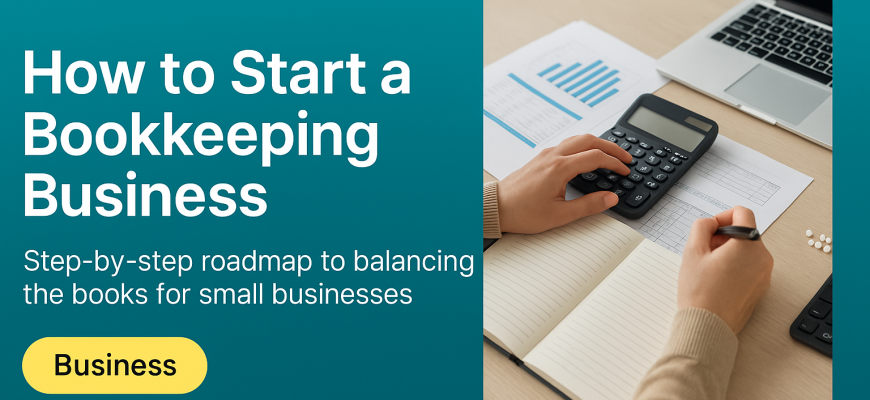If you’ve ever dreamed of running a profitable business on your own terms, bookkeeping might be the perfect path. Many women are discovering that a bookkeeping business offers flexibility, steady income, and the freedom to be your own boss. In fact, bookkeeping checks so many boxes: you can work a flexible schedule, enjoy predictable recurring income, avoid constantly chasing new clients, and start up with low costs in a field with high demand. Every business needs to track its finances, so your skills will always be needed. This means you can build a business that fits around your life — whether you’re a stay-at-home mom, a career-changer, or simply someone seeking financial independence.
As women, we often excel at organization, attention to detail, and building trust — key strengths for a great bookkeeper. With the right plan and mindset, you can launch a bookkeeping business that provides both income and the satisfaction of helping other businesses succeed. This comprehensive guide will walk you through inspirational and practical steps to set up and grow your bookkeeping business. From choosing your niche and getting the proper tools, to landing clients, scaling up, and maintaining a success-oriented mindset, we’ve got you covered. Let’s turn your bookkeeping dream into reality!
- Step 1: Choose Your Niche and Define Your Market
- Step 2: Build Your Bookkeeping Skills and Credentials
- Step 3: Handle the Legal and Administrative Setup
- Step 4: Choose the Right Bookkeeping Software and Tools
- Step 5: Price Your Services and Create Value Packages
- Branding, Marketing, and Getting Your First Clients
- Tips on Scaling Your Business and Creating Recurring Revenue
- Mindset, Support, and Long-Term Potential
Step 1: Choose Your Niche and Define Your Market
Every successful business starts with knowing who you serve. As a bookkeeper, your services can apply to virtually any industry or type of business — after all, every business needs to manage its finances. However, picking a niche can help you stand out in the market. Specializing in a specific industry or client type allows you to hone your expertise and build credibility faster within that segment. It also makes marketing easier, because you can tailor your message to a clear audience.
How to pick a niche? Start by considering your background and interests. If you have experience in retail, maybe you focus on local boutiques or e-commerce sellers. Love wellness or creative arts? Consider serving yoga studios or design agencies. You might choose to specialize in service-based businesses (like consultants, salons, or marketing firms) or product-based businesses (like retailers or manufacturers). For example, some bookkeepers focus on online sellers and master the ins-and-outs of inventory and sales tax, whereas others might serve freelancers who mainly need help tracking income and expenses. There’s no wrong answer — what matters is finding a market you understand and can serve well.
Before finalizing your niche, do a bit of research. Look at your area (or online) to see what other bookkeeping businesses are doing and which industries they serve. If the market seems crowded, you can refine your niche further or highlight what makes you different. On the other hand, if you notice a certain group (say, female-owned boutiques in your city) that no one has positioned themselves to help, that could be a golden opportunity to become “the go-to bookkeeper” for that community. Remember, niching down doesn’t mean you only accept clients in that niche – it just guides your marketing focus. You can always expand later. But in the beginning, a niche will give you direction and help you craft services that truly speak to a specific client’s needs.
Step 2: Build Your Bookkeeping Skills and Credentials
You don’t need an accounting degree or CPA license to start a bookkeeping business. Bookkeeping is a skill you can learn through training and practice, and there are plenty of resources to help you become proficient. That said, investing time in education and credentials will boost your confidence and credibility. Clients trust you with their financial records, so you want to be sure you know your stuff and can deliver accuracy.
Learn the fundamentals: If you’re brand new to bookkeeping, consider enrolling in an online course or program specifically for bookkeeping (there are many tailored for beginners and even for moms or career changers). These courses teach you how to record transactions, reconcile accounts, read financial statements, and use bookkeeping software. You might also find bookkeeping training programs through community colleges, adult education, or platforms like Coursera and Udemy. Start with the basics of accounting principles (like understanding assets, liabilities, equity, revenue, expenses) and how to track them. Many successful bookkeepers begin with a short course and then learn on the job as they take on their first clients.
Get familiar with software: Modern bookkeeping is done with accounting software (more on choosing software in the next step). Most major platforms like QuickBooks or Xero offer free tutorials and even certification programs. For example, you can become a certified QuickBooks ProAdvisor at no cost – this training teaches you the software in depth and, once you pass the exam, gives you a certification badge to show clients. Not only does this deepen your skills, it also signals professionalism. In fact, while formal certification (like becoming a Certified Public Bookkeeper) isn’t strictly required to run a bookkeeping business, it can help you differentiate yourself in a competitive market. Consider pursuing a recognized credential once you have some experience, whether through a national bookkeeping association or through software-specific certifications.
Practice and confidence: If possible, practice bookkeeping in a low-pressure setting to build confidence. You could offer to do the books for a friend’s small business or a family member’s side hustle, or even set up a demo company in your bookkeeping software to enter sample transactions. This hands-on practice is invaluable. It helps you get used to typical tasks like categorizing expenses or reconciling a bank statement. Additionally, staying current is key – subscribe to bookkeeping blogs or YouTube channels, join Facebook groups for bookkeepers, and keep learning. Remember, confidence comes from competence, so the more you prepare yourself, the more you’ll feel ready to offer your services professionally.
Lastly, don’t underestimate the power of a support network. Connect with other women bookkeepers or entrepreneurs – they can share tips, answer questions, and cheer you on. You might find local meetups, online forums, or communities specifically for women in finance. Building your skills is an ongoing journey, and it’s great to have allies along the way.
Step 3: Handle the Legal and Administrative Setup
With your niche defined and skills growing, it’s time to make it official! Setting up the business foundation may not be the most exciting part, but it’s crucial. This step will make your bookkeeping venture a real business in the eyes of the law and your clients. Here are the key pieces of your setup:
-
Choose a business name: Pick a name that represents your brand well. You might use your own name (e.g., “Rivers Bookkeeping Services”) or a creative name that reflects your niche or values (e.g., “Balanced Ledger Solutions” or “Oak Tree Financial Books”). Make sure the name isn’t already in use by checking your state or country’s business registry and doing a quick web search. A good name should be professional and easy to remember. Once you decide, you can register that name when you establish your company.
-
Select a business structure: Determine how you’ll legally organize your company. For many first-time solopreneurs, starting as a sole proprietor (just you, operating under your own name or a DBA name) is the simplest route. It requires minimal paperwork – often you can start operating right away. However, you might consider forming an LLC (Limited Liability Company) for added protection and professionalism. An LLC separates your business finances and liabilities from your personal assets, which can be reassuring as you grow (especially if you plan to hire help later). LLC registration rules vary by region, but typically you’d file articles of organization with your state and pay a fee. If you’re unsure, consult with a local small business office or an attorney to choose the best structure. The key is to get your business registered and compliant with local laws (including any necessary licenses or permits to operate, if required in your area).
-
Take care of legal basics: Once you have a business entity, complete other essentials. Apply for a tax ID (like an EIN in the U.S.) so you can open business bank accounts and file taxes properly. Set up a business bank account strictly for your business finances – this is important. Keeping business and personal finances separate will make your bookkeeping (and life) so much easier and is crucial for maintaining liability protection and clean records. Many banks offer free or low-cost business checking accounts for small businesses. Also, clarify how you will handle taxes: as a business owner, you might need to pay estimated taxes quarterly and collect sales tax if applicable (though bookkeeping services usually aren’t subject to sales tax in many regions – check your local regulations or ask an accountant).
-
Insurance and licenses: Consider obtaining insurance for your bookkeeping business. One common policy is professional liability insurance (also known as errors and omissions insurance) which protects you in case a mistake in the books causes a financial loss for a client. It’s not legally required to have insurance, but it can provide peace of mind given the sensitive financial nature of your work. Even a careful bookkeeper can make an error, and having insurance shields you and your family from potential liability. Insurance costs for bookkeepers are typically modest compared to the protection they provide. Additionally, check if your city/state requires any local business licenses. Generally, bookkeeping is a regulated profession in some places (for instance, in some countries you may need to register as a BAS agent or similar), but in many areas, it’s open as long as you declare your income and follow general business laws.
-
Set up recordkeeping and tools for your own business: It’s a bit meta, but as a bookkeeper you also need to keep your business books in order! Choose a simple accounting method for your business finances – you might even use the same software for your own books. Keep track of expenses (like office supplies, software subscriptions, training courses) and any revenue. This not only keeps you compliant at tax time, it also gets you into the habit of good recordkeeping from day one. Also decide on things like your business phone line (will you use a cell phone or a VoIP service?), a business email address, and a mailing address (some home-based entrepreneurs get a P.O. box or mailbox service for privacy). Creating a professional image in these little details can make a big difference when you start interacting with clients.
Setting up your business might feel overwhelming, but take it one step at a time. Many women entrepreneurs find this phase empowering – you’re officially becoming a CEO! Check each box, ask for help when needed, and soon enough you’ll have a solid foundation to support your growing venture.
Step 4: Choose the Right Bookkeeping Software and Tools
One of the best things about starting a bookkeeping business today is the abundance of user-friendly software available. Gone are the days of paper ledgers; modern bookkeeping relies on digital tools that help you work efficiently and collaborate with clients. Choosing the right software is a big decision early on, because it will be the backbone of your daily work. The good news: you have several excellent options that are both powerful and beginner-friendly.
Why software matters: The software you use will allow you to record transactions, categorize income and expenses, reconcile bank accounts, and generate reports like profit & loss statements or balance sheets. A good platform automates a lot of the process (for example, by linking to bank feeds to import transactions automatically) and reduces errors. It also lets you work remotely with clients – most modern accounting tools are cloud-based, meaning you and your client can access the books from anywhere. When starting out, stick to one or two software platforms so you can master them and streamline your processes.
Top bookkeeping software for beginners: Here are a few popular tools to consider:
-
QuickBooks Online: The most widely-used accounting software among small businesses – in fact, it’s often considered the industry standard. QuickBooks Online (QBO) is cloud-based and offers a full suite of bookkeeping features. It’s known for its robust capabilities and is widely supported; many accountants and small businesses already use it. For a beginner, QuickBooks offers plenty of tutorials and a whole ecosystem of support (including the ProAdvisor program to get certified). It’s a great choice if you want a platform that can scale with you as you grow and handle a variety of client types.
-
Xero: Xero is another highly regarded online accounting system, originally from New Zealand but used globally. It’s especially popular with certain industries (for instance, many e-commerce and product-based businesses love Xero for its strong inventory tracking and multi-currency support). Xero’s interface is clean and user-friendly, and like QuickBooks, it allows you to collaborate with clients easily. If your niche involves inventory or you prefer an alternative to QuickBooks, Xero could be a perfect fit. It’s always wise to see what is common in your target market – some regions favor Xero over QBO. Both QBO and Xero have free trial periods, so you can test them out.
-
Wave Accounting: Wave is a fantastic option for those on a tight budget because it’s completely free for its core accounting features. It’s a no-frills, cloud-based software ideal for freelancers, consultants, or very small businesses with straightforward finances. Wave allows you to do basic bookkeeping – link bank accounts, categorize transactions, and generate basic reports – without a monthly fee. The trade-off is that it’s not as feature-rich as QuickBooks or Xero (for example, Wave has more limited reporting and no built-in inventory management). Also, if your client base grows, some of them might eventually outgrow Wave’s capabilities. But when you’re just starting out or working with micro-businesses, Wave can absolutely get the job done and is extremely beginner-friendly.
-
Bench (and other hybrid services): Bench is a bit different – it’s actually a service that provides bookkeeping for small businesses, paired with its own software dashboard. As a bookkeeper starting your business, you likely wouldn’t use Bench to do bookkeeping yourself (since Bench comes with its own bookkeepers), but it’s worth knowing about such services as part of your landscape. Bench essentially sells a monthly bookkeeping service where the client hands over their financial data and Bench’s team handles the rest, then the client gets simple reports. It’s a very hands-off approach for the business owner. Why mention it here? First, you may encounter clients who have used (or considered) such services, and it’s good to understand how they work. Second, the existence of services like Bench can actually be a selling point for you – you can position your business as a more personalized, flexible alternative. While Bench is ideal for owners who want bookkeeping done-for-them, many small businesses prefer working directly with a dedicated bookkeeper (you!) who understands their unique needs. Aside from Bench, there are other similar services and various add-on tools (like receipt scanning apps, payroll services, etc.) that you can integrate as you grow. But no need to get overwhelmed at the start.
Choosing your tools: When kicking off, pick one primary accounting software and perhaps a few supporting tools. You might decide to use QuickBooks Online exclusively, or offer both QBO and Xero depending on client preference. It’s wise to become proficient in at least one big platform (since mastery will help you work faster and market yourself as an expert). Take advantage of any free certifications – being certified in QuickBooks or Xero not only sharpens your skills but also looks great on your website and marketing materials.
Aside from the main accounting software, think about other tools to make your work easier: For example, a document sharing system (like Dropbox or Google Drive) to exchange reports or receipts with clients, a password manager (you’ll be handling sensitive logins), and possibly a project management or CRM tool to keep track of client tasks and communications. When you’re just starting, you can keep it simple with spreadsheets or a notebook for task tracking, but as your client list grows, you’ll want systems in place (we’ll touch on that in scaling).
In summary, choose software that fits your budget and meets the needs of the clients you plan to serve. The right tools will empower you to deliver professional results and save you countless hours. Don’t be afraid to invest in good software – it’s like a reliable partner in your business. And remember, you can always change or add tools as you learn what works best for you.
Step 5: Price Your Services and Create Value Packages
One of the trickiest questions when starting out is: How much do I charge? Pricing your bookkeeping services can feel like a balancing act. Charge too little and you risk being overworked and underpaid; charge too much and you might have trouble attracting clients while you’re unknown. The goal is to find a sweet spot where your pricing reflects the value you provide and is competitive for your target market.
Research industry rates: Start by getting a baseline idea of what bookkeepers charge. Sources like PayScale or industry surveys can be helpful – for instance, the average hourly rate for bookkeepers (as employees) is around $17/hour in the U.S., with a range from about $10 up to $24 for more experienced folks. But as a business owner, you’re not limited to an hourly wage; you have the potential to earn more by pricing per project or retainer. Many freelance bookkeepers charge higher effective rates than the averages, especially once they have experience. To gauge freelance rates, you can check profiles on platforms like Upwork or Fiverr for bookkeepers with similar experience. Also consider your local market – rates can vary by region (big cities often command higher fees than rural areas, for example).
Hourly vs. package pricing: When starting out, you might feel comfortable charging an hourly rate. This is straightforward – for example, you could charge $20/hour as a newbie and track your time. However, hourly pricing can unintentionally limit your income (there are only so many hours you can work, and if you become faster at your job, you actually earn less per task). An alternative, which many bookkeeping businesses use, is fixed-fee pricing or monthly packages. With this model, you might charge a flat monthly fee for a set scope of work (say, $300 per month for a basic package that includes bookkeeping up to a certain number of transactions, reconciliations, and basic reports). Fixed pricing rewards you for efficiency – if you streamline your workflow, you increase your effective hourly rate while the client pays the same fixed fee. It also gives the client predictability in their budgeting.
Another approach is value-based pricing, where you price based on the value or outcomes you deliver (for example, a client might happily pay more if you also provide budgeting advice or help them save money). Value pricing can be a bit advanced for beginners, but it’s something to keep in mind as you grow.
Create service packages: A recommended strategy is to develop 2-3 service packages to offer. For instance, you might have a Basic package (monthly bookkeeping for a solopreneur with low transaction volume), a Standard package (for a small business with moderate transactions and maybe payroll or invoicing included), and a Premium package (for larger or more complex businesses, including extra services like cash flow analysis or coordinating with their CPA at tax time). By offering tiered packages, you give clients options and can capture a wider range of needs. In fact, using a three-tiered pricing model can encourage clients to choose a package that fits them and stay with you long-term. Be clear about what’s included in each package (e.g., number of accounts or transactions, any meetings or reports, email support, etc.). This clarity manages expectations and helps avoid scope creep.
Know the market rates: It’s helpful to know what businesses typically pay for bookkeeping. Generally, small to medium-sized businesses expect to pay between about $500 to $2,500 per month for outsourced bookkeeping services (quite a broad range!). The low end might correspond to a very small business or partial service, while the high end might include more complex accounting needs or higher-cost locales. If those numbers sound high, remember that as businesses grow, they are willing to invest more in quality financial management. As a beginner, you might start on the lower side for very small clients (for example, some solo entrepreneurs might only afford $150-$300/month). But as you gain experience, don’t be afraid to raise your rates or go after bigger clients. Your time and expertise are valuable.
Pricing tips: Consider offering a free consultation or assessment for potential clients. This lets you understand their needs before quoting a price, and it builds trust. During the consultation, ask about the volume of transactions, number of bank/credit accounts, whether they have payroll, how behind their books are, etc. These factors influence how much work is involved. Also, factor in your niche and specialization – if you provide special expertise (say, you’re great with inventory accounting or you understand the fashion industry inside-out), you can charge a premium for that niche value. Remember that your pricing can evolve: you can start with introductory rates and plan to adjust after your first 1-2 clients or after, say, 6 months once you’ve built confidence. Communicate clearly with clients about your fees, and never hesitate to charge what you’re worth. As you deliver excellent service, your clients will understand the value you bring in keeping their financial world organized.
Lastly, think about contracts and payments. Use a simple client agreement that outlines the services and fees (there are templates available, or you can draft one and have a legal professional review it). Decide on your billing cycle – many bookkeepers invoice monthly or charge a flat monthly fee that’s auto-billed. Set up a system for invoicing (your accounting software may do this, or you can use tools like FreshBooks or simply a PayPal/Stripe recurring invoice). Getting paid promptly is important for your cash flow, so be clear on terms (like payment due upon receipt or within 15 days).
Pricing might feel like a hurdle, but remember, you can refine it as you go. The key is to ensure it’s sustainable for you and fair for the client. When you strike that balance, you’ll have a win-win relationship where you feel motivated to do your best work, and your clients feel they’re getting great value.
Branding, Marketing, and Getting Your First Clients
With your business officially set up and your services defined, the next big step is finding clients. This is where many new entrepreneurs feel nervous, but with the right approach, you’ll build your client roster one step at a time. Let’s break down how to brand yourself and market your bookkeeping business, both online and in your local community.
Build your brand identity: Branding is more than just a logo – it’s the overall impression you give. As a bookkeeper, you want to project professionalism, trustworthiness, and approachability. Start with the basics: get a simple logo (you can DIY with tools like Canva or hire someone affordably), choose brand colors/fonts that you’ll use on your website and social media for a cohesive look, and craft a short tagline or mission statement. For example, if your niche is creatives, your tagline might be “Financial peace of mind for creative entrepreneurs” – something that speaks to your audience. Since this business is you, don’t be afraid to let your personality shine. Clients often choose a small bookkeeping provider because they connect with the person behind the business. If you’re friendly and detail-oriented, make sure your branding conveys that. Also, have a professional headshot taken (or a well-lit, clear photo of you smiling) to use on your website or LinkedIn. People trust people they can see, and as a female entrepreneur, showing your face can help create a personal connection right away.
Online presence – website and social media: In today’s digital age, an online presence is practically essential. Start with a website. It doesn’t need to be fancy or expensive – a one-page or five-page site will do. Include an homepage (with a clear headline like “Bookkeeping Services for [Your Niche]”), an about section (share your story and credentials – this is a great place to mention why you started this business and any relevant experience or certifications), a services page (list what you offer in your packages), and a contact page (with a form or email to reach you). You can build a simple site using platforms like Wix, Squarespace, or WordPress with relative ease. A website lends credibility; many potential clients will look you up online before reaching out.
Next, consider which social media or professional networks make sense for reaching your target clients. A LinkedIn profile or business page is highly recommended – many business owners look for service providers on LinkedIn. Optimize your LinkedIn by stating you are a Bookkeeper or Bookkeeping Professional helping [target market] with [solution]. You could also create a Facebook business page, especially if you plan to network in Facebook groups or run local Facebook ads. Instagram might be useful if your niche hangs out there (for example, a lot of boutique owners or creatives use Instagram). Share content that is helpful, like quick bookkeeping tips, motivational quotes for entrepreneurs, or behind-the-scenes of your work day to humanize your brand. Don’t worry about being on every platform; choose one or two where you can be consistent.
Local networking and outreach: While online marketing is powerful, never underestimate the old-fashioned method of networking, especially for a business like bookkeeping that relies on trust. Start with people you know – let your friends, family, former colleagues, and community know about your new business. You might be surprised how many leads can come from personal referrals. Consider printing some business cards to hand out when you meet people or to leave on community bulletin boards. Attend local business events – many areas have small business networking meetups, Chamber of Commerce events, or industry-specific mixers. By showing up and talking about your business, you plant seeds for referrals. When you meet someone (say, a local café owner or a freelance photographer), and they learn you do bookkeeping, they might either need your service or know someone who does. Have a friendly, genuine pitch about what you do: e.g., “I help small businesses keep their finances organized and stress-free. If you know anyone who might need that kind of help, I’m happy to chat with them.”
Another great strategy is to partner with complementary businesses. Think about professionals who serve the same clients you want to reach but aren’t direct competitors. For bookkeepers, a big one is accountants or CPA firms – often, CPAs focus on taxes or higher-level finance and are happy to refer clients who need day-to-day bookkeeping. Also consider tax preparers, business coaches, or even software consultants. Building relationships with these folks can lead to steady referrals for both of you. For example, if you connect with a local CPA and she knows you’re accepting new bookkeeping clients, she might refer small businesses to you that aren’t a fit for her (and conversely, you can refer clients to her for tax time). It’s a win-win network.
Marketing tactics to get your first clients: When you’re new, the goal is to generate awareness and trust. Here are some tactics to consider:
-
Word of mouth & referrals: This is often the most powerful way to gain clients. Encourage your early clients or contacts to spread the word. Don’t be shy to ask for referrals – if someone is happy with your work, let them know you have room for more clients and would appreciate any referrals. Even before you have clients, you can get referrals from acquaintances who know your character and work ethic. Personal endorsements from one business owner to another carry a lot of weight.
-
Online reviews/testimonials: Once you have a couple of happy clients, ask them for a short testimonial you can put on your website. You can also create a Google My Business profile so that local clients can find you on Google and leave reviews there. Positive reviews will boost your credibility for future prospects.
-
Content marketing: Position yourself as a helpful expert by sharing useful content. This could be a simple blog on your website where you write tips (“5 Bookkeeping Mistakes Small Businesses Make” or “How a Bookkeeper Can Save You Time Each Month”), or posting tips on LinkedIn. If writing isn’t your thing, you could do short videos or even just curate and share relevant articles with your commentary. Content can improve your visibility (especially if you optimize for SEO and local keywords like “Seattle small business bookkeeper”) and it gives you something to share on social channels. It doesn’t have to be a lot – even a blog post or two per month can start building your authority.
-
Direct outreach: Identify a handful of small businesses you’d love to work with – maybe those that fit your niche – and reach out to introduce yourself. This could be through email or even a mailed letter/postcard. Be polite and not pushy: for example, congratulate them on their business (show you’ve done a bit of homework), and mention that you offer bookkeeping services specializing in their field. Leave your brochure or a one-pager of services. They may not need you right away, but when they do hit a pain point with their finances, your introduction could lead them to call you. Direct outreach often has low response rates, but even one client gained can be worth it.
-
Social media and online groups: Join groups where your target clients hang out. This could be a Facebook group for local entrepreneurs, a subreddit for small business, or industry forums. Don’t go in advertising immediately; instead, participate in conversations, answer questions about bookkeeping or taxes, and be genuinely helpful. For instance, if someone asks “I’m overwhelmed with QuickBooks, what do I do?”, you might give a helpful tip in the comments. Over time, people notice and trust you, and you can mention “feel free to DM me if you need more help.” By providing value first, you attract clients organically.
-
Advertising (if needed): In the beginning, you might not need paid advertising, but if you do, consider targeted approaches. For example, a small Facebook ads campaign targeting business owners in your city could raise awareness. Or Google Ads targeting search terms like “bookkeeper in [Your City]”. Keep ad budgets modest until you see results, and always track where inquiries are coming from so you know if it’s working.
Landing that first client: Often, the first client is the hardest to get, but it’s also the most exhilarating. They give you a chance to put all your knowledge into practice. To encourage sign-ups, you could offer a limited-time launch discount or a special bonus for first clients (for example, a free first month, or a free cleanup of last quarter’s books if they commit to 3 months). Just be careful not to undervalue yourself too much – any discount should still make sense for you. Once you get that first client, pour your effort into doing an outstanding job. Early on, you have the advantage of time and focus to really impress. Meet your deadlines, communicate clearly, and maybe even over-deliver a little (like an extra report or a small thank-you gift when you finish the first month). Your reputation will start building from these initial experiences.
Remember, marketing is an ongoing process. Even when you have a few clients, continue marketing so you have a pipeline and can replace or grow clients as needed. Track which strategies are yielding inquiries – maybe you notice a lot of people find you via LinkedIn, or that your local networking is paying off more than online ads. Focus more on what works. Above all, be consistent and patient. Businesses might observe you for a while before they finally make the call. Keep showing up, sharing value, and making connections. In time, you’ll go from wondering where your next client will come from to having a waitlist or the confidence to raise your rates.
Tips on Scaling Your Business and Creating Recurring Revenue
After you’ve got some clients and your bookkeeping business is humming along, you’ll naturally start thinking about how to grow further. Scaling a business means different things to different people. For some, it might mean being able to take on more clients (and maybe hire others to help). For others, it could mean increasing revenue without drastically increasing hours (working smarter, not harder). And for many women entrepreneurs, it also means growing credibility – establishing yourself as an expert and building a brand that attracts business consistently. Let’s explore a few key tips for scaling up and sustaining success:
1. Streamline and systematize your operations: When you were juggling just 2-3 clients, you could get by with basic to-do lists and manual processes. But as you add more clients, efficiency becomes critical. Look at your daily and monthly tasks and find ways to automate or streamline. For example, use your software’s features to the fullest: set up bank feeds to auto-import transactions, use rules to auto-categorize common expenses, and schedule recurring invoices for your retainer fees. Consider using practice management tools or a simple project management app (like Trello or Asana) to track deadlines (e.g., Client A reconciliation by 5th of month, Client B sales tax filing by 20th, etc.). Automation can also extend to client acquisition and onboarding – for instance, having an online form for new clients to fill in their information, or using an e-signature service for contracts. The more you create systems (checklists, templates, standard operating procedures), the easier it will be to handle more work without feeling overwhelmed. Successful bookkeeping firms often attribute their growth to well-defined processes that ensure consistency and quality.
2. Consider hiring or outsourcing as you grow: Initially, you are the chief everything officer – doing all the client work, admin, marketing, etc. But as your client list expands, identify the tasks that someone else could do, so you can focus on higher-value activities. Perhaps you bring on a part-time assistant to do routine data entry or to manage your social media posts. Or you could subcontract another bookkeeper for a few hours a week to help during crunch times. If you prefer to remain a one-woman operation, that’s completely fine too – scaling doesn’t have to mean taking on employees. You can scale by focusing on more profitable clients and trimming the less profitable ones (more on that in a second). However, if your vision is to build a larger firm or simply reduce your personal workload, building a team is a path to explore. Start small – even 5 hours a week of help could free up 5 hours for you to market or to serve an additional client, which increases revenue. Just be sure to maintain quality control and train anyone you bring in thoroughly, so your clients still get top-notch service.
3. Focus on your most profitable niches and services: As you gain experience, you’ll discover which types of clients are the best fit for you – not just personality-wise, but financially. You might find that, for example, solo consultants are easy to work with but only can pay a small fee, whereas a medical clinic or a thriving e-commerce store might pay a much higher monthly fee but also have more complex needs. Analyze your client list and see where your highest hourly value is coming from. It could be that you decide to specialize even more (maybe you notice you have 3 clients in the wellness space and they’re great to work with – you could lean into that). Don’t be afraid to refine your niche as you go; it’s part of growth. You can tailor your marketing to attract more of the lucrative clients and gently turn away or even discontinue with those that might be dragging you down (for instance, a client that constantly pays late or demands a lot outside the scope). By focusing on a niche, you also become more efficient (since similar clients = you can apply learnings across them and maybe even do batch work).
4. Build your credibility and expertise continuously: Scaling a business isn’t just about size; it’s about growing your reputation so that you become a magnet for opportunities. Continue to invest in yourself. That might mean obtaining further certifications or licenses as available in your field. Becoming a Certified Bookkeeper through a professional organization or obtaining an advanced certification in QuickBooks or Xero can set you apart and reassure bigger clients of your skills. Collect testimonials and case studies from satisfied clients – ask if you can write a short success story about how your bookkeeping helped their business (maybe you caught costly errors or freed up their time to focus on growth). These stories are gold for convincing future clients. You can also raise your profile by participating in industry events or online webinars – perhaps giving a talk at a local business workshop about financial best practices, or being active in online communities. All these actions build your credibility and create opportunities for clients to discover you organically. When people see you as an expert in your niche, you won’t have to chase clients; they will come to you.
Additionally, as your brand grows, consider creating content on larger platforms (write a guest article, appear on a podcast, etc.). For example, being featured in a local newspaper’s business section as a “Bookkeeping Expert” or writing a piece on a site like LinkedIn or Medium about small business finances can boost your authority. Over time, you might even develop your business into adjacent areas, like offering financial consulting or coaching for new business owners in addition to bookkeeping. The possibilities expand as you establish your name.
5. Emphasize recurring revenue and client retention: One of the beautiful things about bookkeeping is that it naturally lends itself to recurring revenue – most clients will need continuous service (monthly, quarterly, annual) rather than a one-time project. As you scale, focus on maximizing this aspect. It’s far easier to maintain a base of satisfied recurring clients than to constantly find brand new ones. Treat your clients well and aim to retain them for the long term. This could involve adding value beyond just crunching numbers – for instance, sending them a mid-year financial health check or scheduling a quarterly review meeting to talk through their figures. These actions demonstrate that you’re invested in their success, and it keeps the relationship strong. Happy clients often stick around for years and provide that stable income that makes your business sustainable (and your life less stressful).
Also, think about expanding services for existing clients as a scaling strategy. Perhaps a client initially just wanted basic bookkeeping, but now you could pitch an additional service like preparing a budgeting forecast for them, or handling their sales tax filings, for an extra fee. This increases the value of each client relationship (and your revenue) without requiring you to find a new client. Always align any new service with your expertise – never take on something you’re not comfortable with just for more money, as that can backfire. But within your realm, there may be natural extensions of your service that clients would gladly pay for.
6. Leverage technology for scalability: We touched on software before, but as you grow, consider more advanced tools that larger firms use. For instance, workflow automation tools (Zapier, etc.) that can connect your apps, expense management tools like Dext or Hubdoc for gathering receipts from clients, or time-tracking and billing software to manage multiple clients. Cloud-based accounting and the ecosystem around it (apps for invoicing, payroll, inventory, reporting) are constantly evolving. Staying savvy with tech will allow you to serve more clients with less manual effort. This is part of investing in your knowledge – the more you evolve with the platforms and features in your industry, the more efficient and competitive you’ll be.
7. Know your limits and set boundaries: Scaling doesn’t mean you have to build a giant operation (unless that’s your dream!). It’s perfectly okay to reach a level – say 10 clients – that provides the income and work-life balance you desire, and decide that’s enough for now. Growth can also mean improving quality and profitability, not just quantity. As a woman entrepreneur, especially if you’re balancing family or other commitments, define what success looks like for you. It might be a six-figure revenue goal, or it might be making a decent income while working 25 hours a week. The beauty of your own business is that you get to decide. Don’t compare yourself too much with others; focus on sustainable growth that aligns with your life goals.
Finally, remember that scaling and sustaining success is a marathon, not a sprint. Continue to learn (take that advanced course, attend webinars, read books on entrepreneurship), continue to network (the contacts you make can lead to opportunities years down the line), and continue to fine-tune your business model. The world of small business is always changing – new technologies, new regulations, new market needs. Stay curious and adaptable. As NerdWallet wisely notes, make sure you grow alongside the businesses you serve: keep your skills up to date and evolve with the industry, attending conferences or events to stay sharp. In doing so, you’ll ensure that your business remains relevant, competitive, and ready to seize new opportunities as they arise.
Mindset, Support, and Long-Term Potential
Embarking on the journey of starting a bookkeeping business is exciting, but it can also feel daunting. As we wrap up, let’s talk about the heart of this journey – your mindset and support system. These can be as crucial to your success as any marketing plan or technical skill.
Cultivate a success mindset: Believe that you are capable of growth and success. Entrepreneurship is as much a personal growth journey as a business venture. There will be moments of doubt – maybe a prospect says no, or you hit a learning curve that frustrates you – but remember why you started. Perhaps you wanted to provide a better life for your family, or to have the freedom to control your schedule, or simply because you love numbers and helping others. Keep that “why” in focus to drive you forward. Replace thoughts like “Can I really do this?” with “I am learning and improving every day, and I will make this work.” Surround yourself (even if virtually) with positive examples – other women who started from scratch and now run successful businesses. Their stories can remind you that you’re not alone and that challenges can be overcome. A growth mindset means viewing challenges as opportunities to learn, rather than as failures. If something doesn’t go as planned, ask “What can I do differently next time?” and know that every step, even the stumbles, are bringing you closer to your goals.
Find your tribe and support network: While you may be a solo business owner, you should never feel you have to do it all in isolation. Seek out communities of like-minded entrepreneurs. There are many networks specifically for women in business where you can share experiences and get advice. For example, Facebook groups like “Women Entrepreneurs Networking” or forums like the NatAssociation of Women Business Owners (NAWBO) can provide camaraderie and resources. Within the bookkeeping and accounting field, there are online groups and associations (on LinkedIn or specialized forums) where you can ask technical questions or discuss client management issues. You might also consider finding a mentor or coach. Since you’re reading a blog by Alex Rivers (a business coach for women), you already know the value of guidance – don’t hesitate to invest in coaching or mentorship if you need more personalized support. Sometimes a few sessions with a coach can clarify your path and boost your confidence dramatically.
Also, involve your personal circle. Explain to your family or close friends what you’re trying to build – their encouragement can be a big morale booster, and they might offer help in ways you didn’t expect (whether it’s watching the kids for a couple hours while you work, or simply being a sounding board for ideas). The journey has ups and downs, and having people cheer you on or empathize on a rough day makes a huge difference.
Embrace lifelong learning: The most successful entrepreneurs never stop learning. Be open to feedback from clients – it can make you better. Stay curious about changes in tax laws, new software features, or better marketing techniques. This willingness to learn and adapt will keep you ahead of the curve. Perhaps set aside a little time each week or month for professional development (read articles, take an online mini-course, etc.). It keeps you sharp and inspired.
Long-term potential – dream big: Today, you might be just hoping to sign your first few clients. But don’t lose sight of the big picture. In the long run, your bookkeeping business could become anything you want it to be. Maybe in five years, you’ll have a small team and an office, serving dozens of businesses while you steer the ship as CEO. Or maybe you’ll remain a boutique solo practice but be so well-regarded that you charge premium rates and pick only the clients you love to work with. You could even evolve into related areas – some bookkeepers branch into tax preparation, financial coaching, or outsource CFO services for their clients. The sky is truly the limit. One of the reasons bookkeeping is such a fantastic foundation is the recurring revenue and relationships you build: you’ll develop ongoing partnerships with clients, giving you a stable income base. From that base, you can grow steadily and even explore new revenue streams (perhaps creating a bookkeeping course for DIY-inclined business owners, writing an e-book, or adding consulting services).
And yes, it is absolutely possible to reach a six-figure income with a bookkeeping business. Many have done it by scaling smartly and delivering great value. There is no glass ceiling here – you set your income goals, and with hard work and smart strategy, you can reach them.
Encouragement to take action: In the end, all the planning and learning means nothing if you don’t take action. The difference between those who dream and those who do is just that – doing. You’ve armed yourself with knowledge by reading this guide. Now it’s time to trust yourself and take the first step. That might be signing up for a class, or registering your business name, or calling a potential client who was on your mind. Do one thing today that moves you forward, no matter how small. Momentum builds with each action.
As a business coach who has seen many women transform their lives through entrepreneurship, I want to tell you this: you are capable of more than you know. The path of starting a bookkeeping business will challenge you, but it will also reward you in so many ways – not just financially, but in confidence, pride, and freedom. Whenever you feel unsure, remember that every successful bookkeeper out there started as a beginner too. They learned, they persevered, and they made it – and so will you.
Your journey forward: Keep this guide as a reference, but also remember that your journey will be unique. Embrace the uniqueness. Stay organized, stay positive, and stay connected to your purpose. With determination and heart, you can build a thriving bookkeeping business that not only provides a great income, but also fits your life and maybe even inspires others around you.
Now, take a deep breath, believe in yourself, and go for it. The world needs your talents, and there are businesses out there right now who could use a bookkeeper like you to lighten their load. You’ve got this – here’s to your success and the wonderful business you are about to create!









